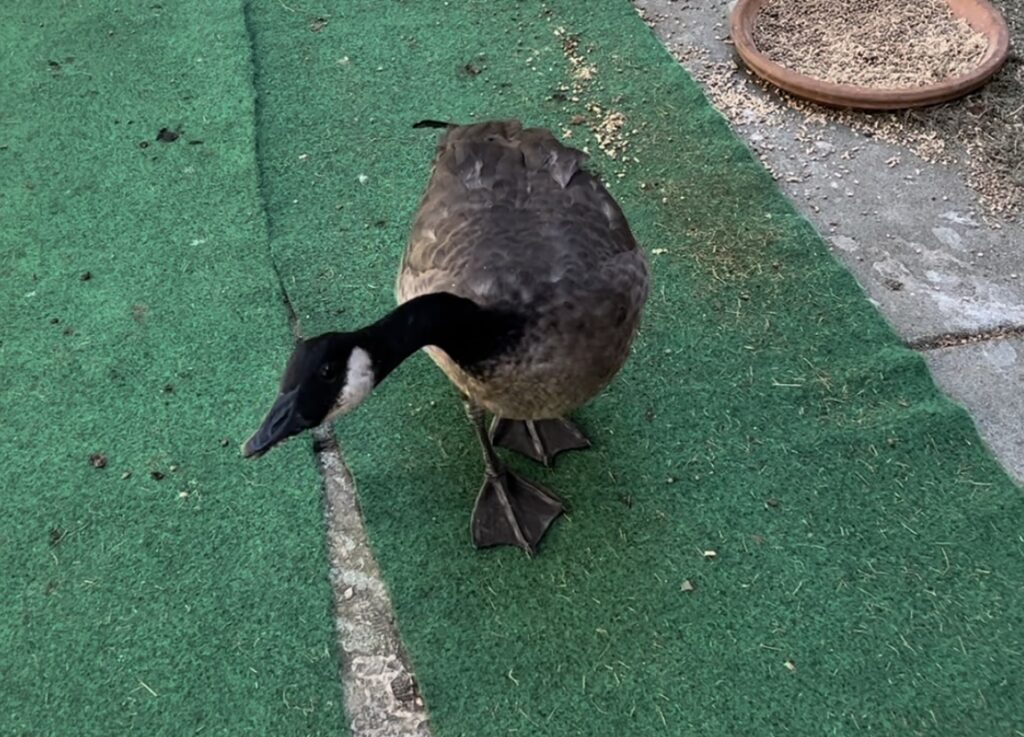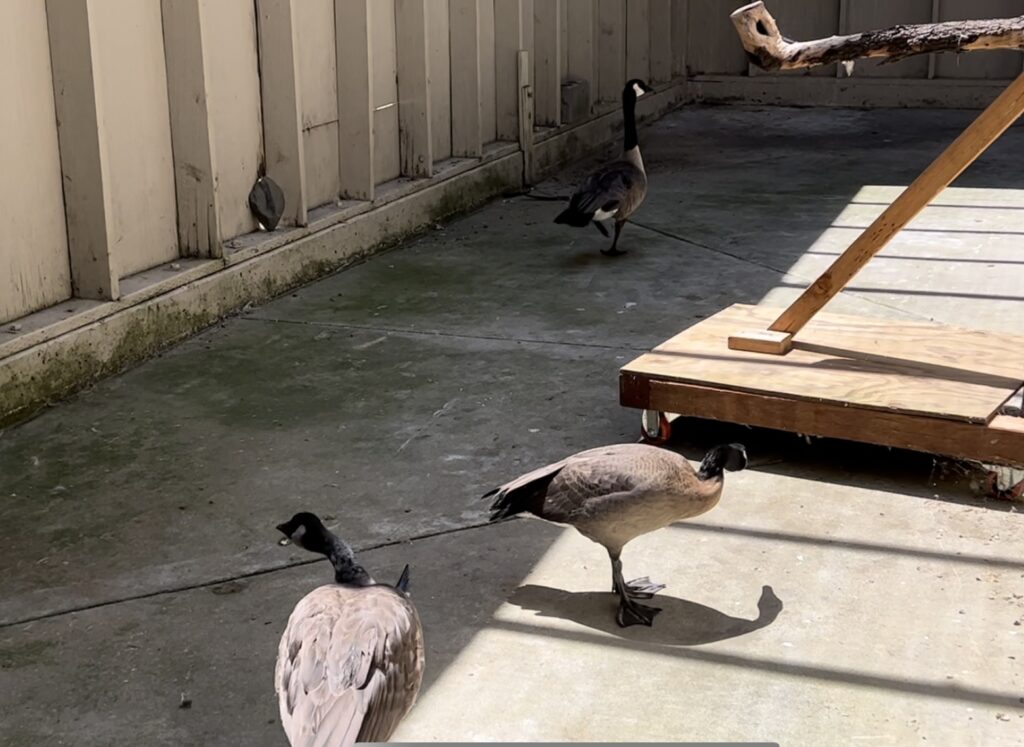Gulliver The Friendly Goose
- back to blogs
It’s that time of year again when the daylight lasts a little longer, the flowers begin to bloom and the birds sing enthusiastically announcing another season of building nests and raising babies. Some species of birds work hard to win over a new mate each year while others, such as the Canada goose, stick with their one mate for life. Not only do Canada geese show admirable commitment to one another, they are also surprisingly wonderful foster parents and will often accept a gosling (baby goose) into their brood which they did not originally hatch. This makes things quite convenient for us as wildlife rehabilitators when receiving calls from the public for orphaned or abandoned goslings with no parents to be found. After an initial assessment confirming that the gosling is in good health, we set out to find a match with another goose family, where the young are of similar age and the environment is just right. Last year we had many of these calls and every single gosling was easily fostered into a new family. That is, until Gulliver arrived. When Shasta Wildlife received a phone call from a well-intentioned couple who had found a baby goose two weeks prior and had been caring for him in their home, we knew we had a difficult situation on our hands. Goslings will attach to just about anything as their parent figure (remember the book “Are You My Mother”?) and can imprint on humans very easily. Although this may seem like an irresistible opportunity to care for an animal yourself, it is actually quite dangerous for these wild birds and Gulliver quickly became a good example of why. Thankfully his story has a happy ending, but it may have gone very differently if things had not unfolded the way they did.
Upon receiving the two week old gosling into our care and determining he was indeed healthy and ready to be fostered out, I packed him into a carrier and headed to a lake where many other goslings had successfully been fostered out to other families. I attempted to release him into family after family, most of which were willing to accept him into their group, yet each time he would run back to me or follow after other humans walking along the nearby trail. I tried several different locations and goose families, hoping that eventually he would realize that he was meant to stick with one of them. One of our volunteers even took us out on a paddle boat to reach a family of geese on her private pond who were also willing to accept him, yet he simply wandered off alone in search of his human caretakers. And so, once again, I took him back and decided to try again a few days later, thinking that this time it had finally worked as I watched little Gulliver actually swim off with a family, blending in perfectly with the others. Later that evening I decided to head down at sunset to check in on him, hoping I wouldn’t find him wandering the streets or missing altogether. I was able to spot the family he had swam off with, but when I realized they were one gosling short my heart sank. Where had he gone!? After searching the lake with my binoculars in hand for several minutes, I saw him swimming on his own, very much lost and alone. I waited and waited until eventually he swam up to the bank looking exhausted and disoriented. I scooped him up and brought him back with me once again, feeling discouraged at the possibility that we may not be able to get him reintroduced into the wild at all. After realizing we were going to have to care for this little goose for longer than we had planned, I decided to give him the name Gulliver because of all the travels he’d had. Not only had I taken him out on several release attempts, but I was also told that the finders had originally seen him walking for over a mile through the neighborhood as just a tiny yellow fluff ball of a baby before getting rescued. He had even been brought to church one Sunday as the subject of an inspirational sermon on perseverance during the two week period before he was brought to Shasta Wildlife. So, Gulliver seemed like the perfect name.
Unsure of what else we could do for Gulliver, we attempted to de-socialize him by keeping him in our outdoor pond enclosure at the Shasta Wildlife facility with a few juvenile ducks who were also in our care, hoping that he’d at least begin to recognize that he was not actually a human and become familiar with other waterfowl. Despite our best efforts, however, he remained quite friendly with humans. This is a dangerous situation for any wild animal to be in as releasing them back out into the wild with a strong attachment to humans like this could put their lives at risk. Not only did Gulliver not know how to “be” a goose, and therefore have a lower chance of survival, we did not want him approaching members of the public. These situations put us in a sticky situation as wildlife rehabilitators, as oftentimes an imprinted animal is deemed to be non-releasable and the options at that point are slim.
But then came the phone call that saved us. This time it was for an injured adult canada goose who had sadly been attacked by a dog. In the past we would not normally take in adult geese but this seemed like it could be the answer to our Gulliver predicament and we were willing to help. As long as the adult was not critically injured and was viable for rehabilitation, it could become the lifeline that Gulliver desperately needed in order for him to learn from a parental figure and build attachment to another member of his species. After capturing and assessing the adult, we determined that her wounds were treatable and we set out to get her back to full health, with the intention of introducing her to Gulliver when ready. After a few days of treating her we put them together, supervising to make sure there was no aggression from either bird. It turns out we had no reason to worry, as the adult showed zero signs of aggression and ended up running away from Gulliver’s enthusiastic greetings. He was so excited to meet another goose! We couldn’t have been happier to have found a parent figure to introduce him to and for him to take to her so quickly. They settled into living together well as “Mama Goose” continued to heal and Gulliver grew more attached to her and less so to us.
About two weeks later another call came in for a gosling that had been living on a farm with domestic geese for the past six weeks. We were concerned about getting in another potentially imprinted bird, but because we happened to already have the other two geese in our care we figured integrating them into our newly formed family was the best chance it had at rehabilitation as well. Thankfully gosling number two was much less familiar with people due to it having been living with the domestic geese all this time, and the others easily accepted him into their now family of three.
When Mama Goose had fully healed and the goslings were grown and ready for release, I set out to find the ideal spot. Gulliver had completely attached himself to the others and was much less interested in humans, so we felt confident that he would be safe in the wild but we still wanted to find a location that was not overly populated with people in order to give him the best chance possible. After searching the local areas and reaching out to several private landowners, I was generously given access to a couple of very large private ponds where hundreds of other canada geese were already living, far away from the public. It truly was the perfect place to release our little family that we had all grown quite fond of. So we picked the day, loaded them up into crates and drove them to their new home where they could start their new lives together back in the wild. Watching Gulliver and his adoptive sibling take flight for the first time, circling over Mama Goose while honking exuberantly was without a doubt the highlight of the season for me. After testing out their wings, they each came back to her and the three of them eventually swam out into the large open water, the two young geese following closely behind as she led them around their new oasis. Before we turned back to leave, all three of them flew up together for a moment before swimming off to the other side of the bank. We were so thrilled to have been able to rehabilitate all of them, knowing that Gulliver was in good hands and had finally learned how to be a goose.
Written by Kacie Finn,
Head of Waterfowl at Shasta Wildlife Rescue and Rehabilitation






